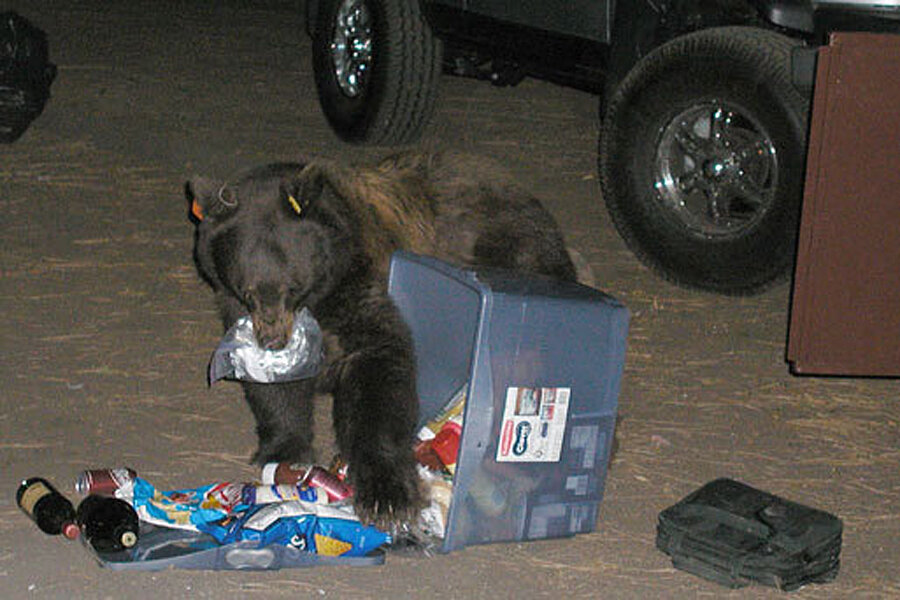Bears stealing fewer picnic baskets at Yosemite
Loading...
Remembering to lock up everything from baby wipes to bratwurst may be irksome for Yosemite National Park visitors, but a new study finds the park's stringent food storage rules slashed the amount of human food eaten by black bears by 63 percent.
Yosemite National Park is home to hundreds of black bears — no one keeps an accurate count — only some of which seek out human food and garbage. After a record 1,584 bear incidents in 1998, park officials enacted new food storage requirements to stop bears from stealing food and garbage. These measures help prevent bear deaths and human-bear interactions, because a food-reliant bear often becomes an aggressive bear, according to the park. With more than 4 million visitors yearly, Yosemite now spends about $500,000 annually on supplies, outreach and activities meant to prevent bears from getting into human food. [Image Gallery: Beastly Bears]
Access denied
According to the new study, which tracked the diets of nearly 200 bears by analyzing hair samples, the massive effort is working. Chemical signatures in the hair differentiate between human and wild food sources. The findings were published in the March issue of the journal Frontiers in Ecology and the Environment.
"What we found was that the diets of bears changed dramatically after 1999, when the park got funding to implement a proactive management strategy to keep human food off the landscape," Jack Hopkins, lead study author and a wildlife ecologist at the University of California, Santa Cruz. "This suggests that the bear's diets are likely going back to their natural diet."
Among bears that eat human food, only 13 percent of their diet came from anthropogenic, or human sources, between 2001 and 2007, Hopkins found. That's the same as in the park's early years, between 1915 and 1919, when only a few thousand visitors made the long journey into Yosemite Valley. Hopkins examined the early diet of Yosemite's black bears by snipping hair from museum specimens.
Established in 1890, Yosemite National Park hasn't always had a hands-off approach to feeding its bears. Between 1923 and 1971, the park operated artificial feeding areas, to attract bears for visitors who wanted to view the local wildlife. A trout hatchery in the park, open between 1927 and 1956, also offered bears a spot for easy gorging.
The bear's diet reflects these changing food sources, the study shows. The proportion of human food was 27 percent between 1928 to 1939, and 35 percent between 1975 to 1985, among bears who ate a non-natural diet. Throughout the study, Hopkins also found bears in the park who subsist only on their natural diet of berries, nuts, insects and meat.
Prevention is best
The findings support the management approach of preventing bear access to food. Brown metal food storage lockers for campers, cylindrical plastic storage containers for backcountry hikers and funding for inspections by rangers were added in 1999 in Yosemite. Everything must go into storage, even toothpaste. Nothing should remain in sight in cars, where the sight of a cooler or storage bin might tempt a hungry bear to bust open a window.
"Reducing the amount of food on the ground and making sure visitors are compliant with food storage has led to this management success," Hopkins told Live Science. "It appears that management that is related to preventing bears from becoming too conditioned to food in the first place is one of the best things to put money into."
Previous research by Hopkins and his colleagues also found that stopping bears from getting that first taste of human food can break the chain of picnic-basket stealers. For example, bears that are raised by moms who snack on human food also strike out in search of campgrounds and other human sources once they're on their own. "They carry that information with them throughout their lives," Hopkins said. And problem bears that are moved away from people eventually make their way back to their favorite food sites, another study found. The reward? Bears that eat human food are bigger and bear more cubs than those who subsist solely on their traditional diets, though they have a shorter life span. That's because they're eventually killed as a nuisance or by hunters, because the bears are near developed areas.
Email Becky Oskin or follow her @beckyoskin. Follow us @livescience, Facebook & Google+. Original article on Live Science.
- Smile! Rocky Mountain Critters Caught on Camera
- 7 Iconic American Animals
- Stunning Stargazing In Yosemite National Park | Video
Copyright 2014 LiveScience, a TechMediaNetwork company. All rights reserved. This material may not be published, broadcast, rewritten or redistributed.







